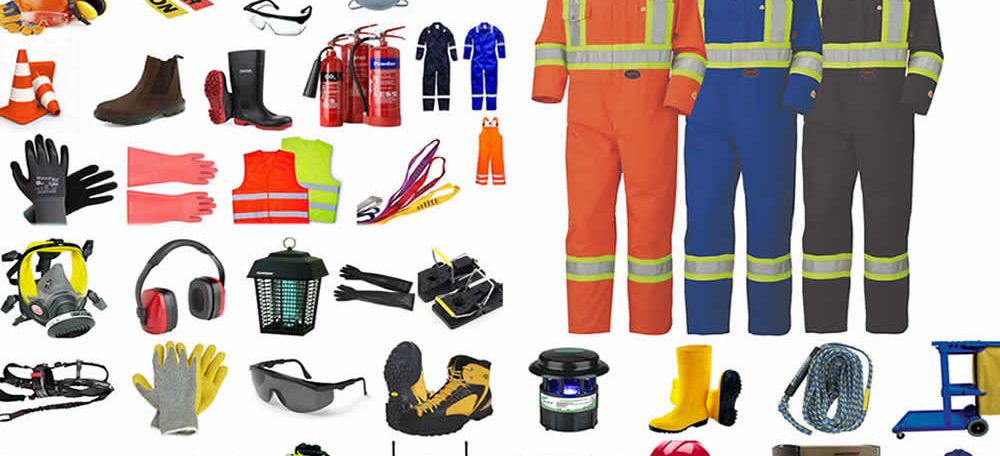This post discusses the meaning of Safety Equipment, types of safety equipment and furthermore, the importance of wearing the equipment.
What is the meaning of safety equipment?
This refers to protective gear and tools that workers use to protect themselves from harm and prevent accidents while on the job. These items may include gloves, helmets, safety glasses, earplugs, high-visibility jackets, and respirators, among others.
To mitigate the hazards of this work to acceptable levels, a variety of different types of safeguards need to be used. There are different levels of effectiveness of safeguards that can be utilized to keep workers safe. The most effective safeguard is elimination of hazards followed by substitution, engineering controls, administrative controls, and PPE.
TYPES OF SAFETY EQUIPMENT
Some common types include:
Personal protective equipment (PPE)
PPE includes everything from hard hats, safety glasses, and gloves to respirators and full-body suits. PPE is designed to protect workers from physical, chemical, radiological, and other hazards.
Fall protection
Fall protection equipment includes harnesses, lanyards, and anchor points that protect workers from falling from heights.
Fire safety equipment
This equipment includes fire extinguishers, smoke detectors, and sprinkler systems. This equipment is essential for protecting workers from fires and preventing property damage.
READ: Gas Exploration & Development Permit Requirements
Hazardous material handling equipment
Hazardous material handling equipment includes spill kits, gloves, and goggles. This equipment is designed to protect workers who handle hazardous chemicals and other materials.
Machinery safety equipment
This machinery includes safety guards, lockout/tagout equipment, and emergency shut-off switches. This equipment helps prevent workers from being injured by moving machinery.
READ: Oil and Gas Regulatory Consulting
WHY IS IT IMPORTANT TO WEAR SAFETY EQUIPMENT?
Wearing safety equipment is an essential requirement for performing high-risk tasks. In general, safety equipment is designed to either mitigate or manage risks associated with different activities.
Here are just some of the reasons why it’s so important to wear safety equipment.
Preventing Accidents
One of the primary reasons to wear equipment is to prevent accidents from occurring. In industrial settings, workers are often exposed to hazards such as falling debris, chemical spills, and electrical shocks.
Wearing the correct safety equipment can protect you from these dangers and prevent accidents from happening.
For example, hard hats can shield you from falling objects, chemical-resistant gloves can protect your hands from hazardous substances, and safety glasses can prevent eye injuries from flying debris.
Reducing Injuries
Even if an accident does occur, wearing protective equipment can significantly reduce the severity of any resulting injuries.
For instance, a properly fitted respiratory mask can protect you from inhaling harmful gases, while steel-toed boots can prevent foot injuries from heavy machinery.
In some cases, this equipment may even save your life. For example, wearing a safety harness can prevent falls from heights, and fire-resistant clothing can protect you from flames and burns.
Promoting Compliance
Wearing this personal protective equipment is not only essential for your personal safety but also for ensuring compliance with workplace regulations.
Many industries, such as construction and mining, have strict safety requirements that must be met in order to ensure worker safety.
By following these guidelines and wearing the necessary safety equipment, you can avoid costly fines and protect your company’s reputation.
Improving Productivity
Wearing this equipment can also have a positive impact on your workplace productivity. When workers feel safe and protected, they are more likely to focus on their tasks and work efficiently.
Conversely, if workers are worried about their safety, they may feel distracted or anxious, which can lead to mistakes and delays.
By providing the necessary training and protective equipment, employers can help their workers feel confident and focused.
Setting a Good Example
Finally, wearing this protective equipment’s can set a positive example for your colleagues and customers. When you prioritize safety in the workplace, you demonstrate your commitment to protecting yourself and those around you.
This can inspire others to do the same, helping to create a culture of safety and responsibility within your organization.

